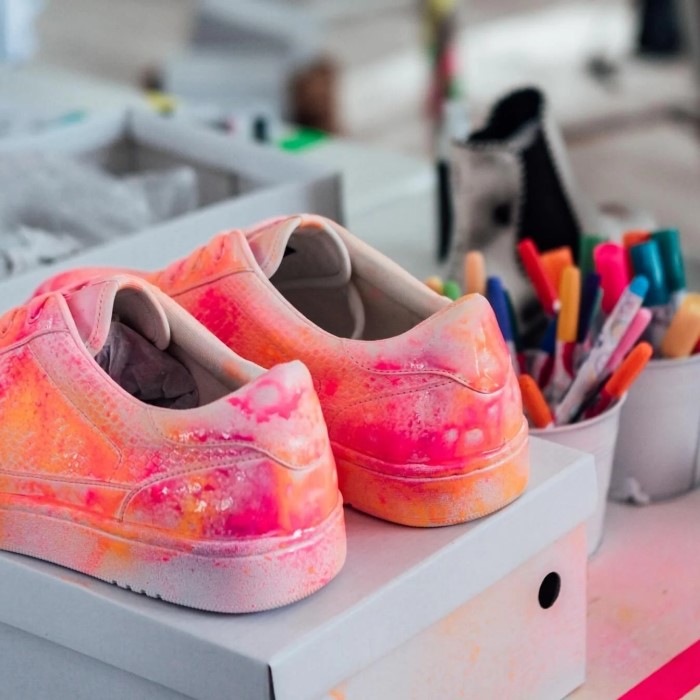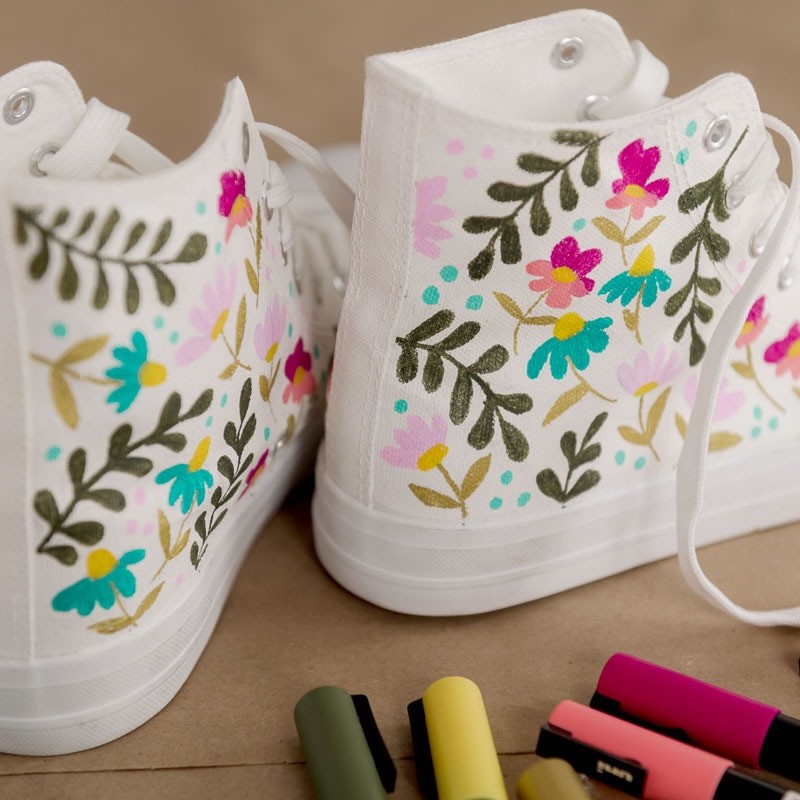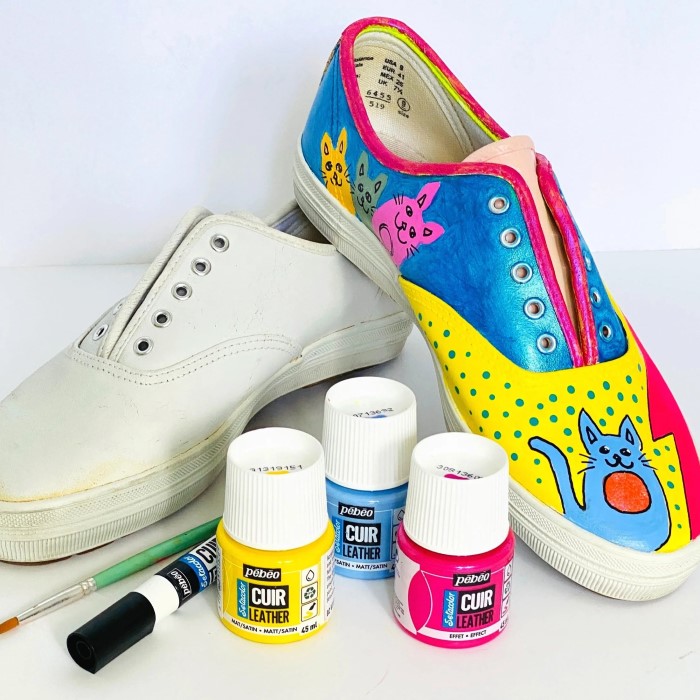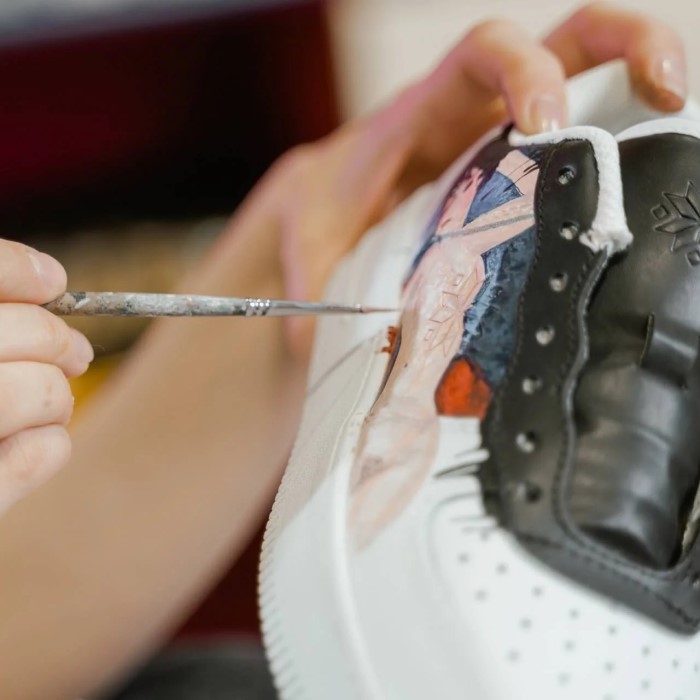Introduction: Making a Statement with Painted Shoes
In today’s vibrant world of fashion, self-expression has become more important than ever. One exciting way to showcase individuality is through DIY projects, particularly painting shoes. Knowing what paint to use on shoes can transform ordinary footwear into unique masterpieces that reflect your personality and style. Whether it’s rejuvenating an old pair of sneakers or creating a bold custom design for a special event, the right paint choice can make all the difference.
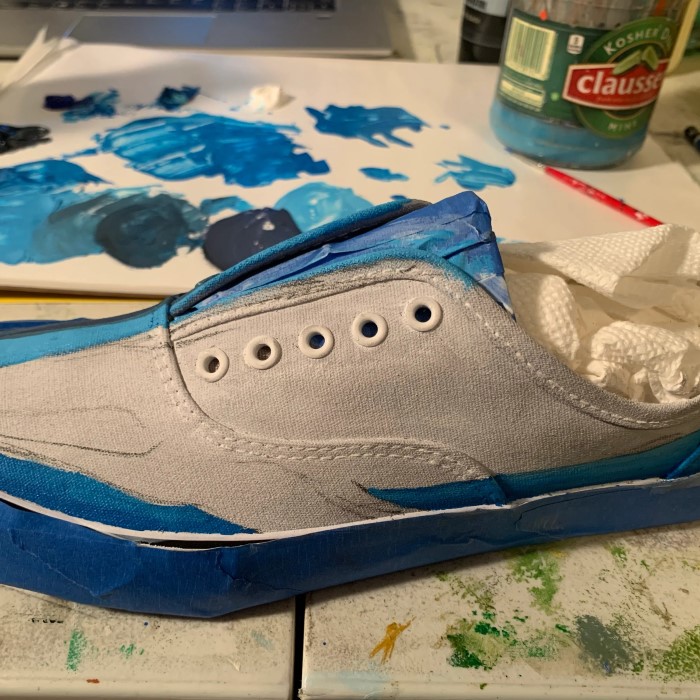
As DIY culture continues to flourish, more people are eager to personalize their footwear with paint. This guide will explore various types of paints suitable for shoe customization, essential techniques for application, and tips to ensure your designs withstand the test of time. Join us as we delve deeper into the art of painted shoes and how to make a fashionable statement that turns heads!
Understanding the Different Types of Paints
1. Acrylic Paint
- Versatile Application: Acrylic paint is widely regarded as one of the best options for painting shoes. It adheres well to various materials, including leather, canvas, and synthetic fabrics.
- Color Variety: Available in a vast array of colors, acrylic paint lets you create highly personalized designs. You can mix and match to achieve the exact shade you desire.
- Quick Drying Time: This paint dries relatively quickly, allowing for faster layering and the ability to complete your project in a shorter time frame.
2. Fabric Paint
- Designed for Textiles: Fabric paint is formulated specifically for use on textiles, making it a strong choice for fabric shoes and clothing. It stays flexible after drying, ensuring that your designs remain intact.
- Long-Lasting Quality: Most commercial fabric paints are machine-washable and resistant to fading, ensuring that your designs hold up well over time.
- Multiple Application Methods: Fabric paint can be applied with brushes, sponges, or even spray bottles for more dynamic designs.
3. Leather Paint
- Targeted Use: This paint is designed specifically for leather shoes. It penetrates the leather surface, creating a durable bond that resists peeling or cracking.
- Range of Finishes: Leather paint often offers various finishes, such as matte, satin, or glossy, allowing for aesthetic customization.
- Flexible Drying: It is designed to maintain its flexibility, so it won’t crack as the leather moves.
4. Spray Paint
- Efficient Coverage: Spray paint is an excellent choice for covering larger areas quickly. It allows for an even coat that may be challenging to achieve with brushes alone.
- Smooth Application: When applied correctly, spray paint provides a sleek finish. However, it requires careful handling to avoid overspray on unwanted areas.
- Specific Formulations Available: Ensure you choose spray paint suitable for the type of material your shoes are made from, whether fabric, leather, or synthetic.
Choosing the Right Paint for Your Project
1. Identify Shoe Material
- Different Materials Require Different Paints: It’s crucial to determine the material of your shoes before selecting paint. For instance, leather shoes need leather paint, while canvas and synthetic shoes work best with acrylic or fabric paint.
- Compatibility: Using the proper paint ensures better adhesion, durability, and overall success with your creative designs.
2. Consider Project Type
- Revamping Old Footwear: If you’re refreshing a tired pair of shoes, think about using vibrant acrylic or fabric paint for a fresh look.
- Custom Design Creation: For personalized artistic projects, high-quality fabric paint or acrylic would provide the best results due to their versatility and range of colors.
3. Think About Longevity
Paint Durability:
-
- When selecting paint for your project, keep in mind that not all paints have the same level of durability.
- Research different brands and types of paint to find those specifically labeled for use on shoes or fabric, as they tend to provide better longevity.
- Look for paints that boast good resistance to wear and tear; these will stand up better against everyday use and environmental factors.
- Additionally, consider paints that are resistant to washing or moisture; this ensures your designs remain intact even after cleaning.
- By choosing high-durability paints, you can significantly extend the lifespan of your designs, ensuring they look great for longer.
Sealing Your Artwork:
-
- Once you have completed your painting and allowed it to dry thoroughly, it’s essential to consider sealing your artwork.
- Using a clear acrylic sealer can provide an additional layer of protection for your painted designs.
- The sealer helps guard against potential scratches, scuffs, and other types of damage that may occur during regular use.
- Moreover, sealing your artwork can also prevent fading caused by exposure to sunlight and other environmental factors, helping to maintain vibrant colors.
- Apply the sealer according to the manufacturer’s instructions, ensuring an even application for optimal protection.
- Taking the time to seal your design will enhance its durability and give you peace of mind that your creative work is well-protected.
Techniques for Painting Shoes
1. Preparation is Key
- Thorough Cleaning: Start by cleaning your shoes to remove dust, dirt, and oils that could affect paint adhesion. Rubbing alcohol or a mixture of soap and water works effectively for this purpose.
- Remove Laces and Accessories: Take out shoelaces and remove any decorative elements to ensure you can paint every part of the shoe evenly.
2. Applying the Paint
- Use High-Quality Tools: Depending on the paint type you choose, select appropriate brushes, sponges, or spray nozzles for application. A fine brush is great for detailing, while sponges work well for broad surfaces.
- Layer Your Paint: It’s best to build your design with multiple layers of paint rather than applying one thick coat. Allow each layer to dry thoroughly before adding the next for best results.
3. Finishing Touches
Add Creative Designs
1. Wait for the Base Color to Dry
- Importance of Drying Time: Before adding any additional elements to your shoe design, ensure that the base color is completely dry. This step is crucial; otherwise, the new paint may smudge or mix with the existing color.
- Check for Touches: Gently touch the surface of the shoe to confirm that it feels dry to the touch. If it still feels tacky, allow extra drying time.
2. Choose Your Design Method
- Stencils:
- Using Pre-Made Templates: Stencils can provide a clean, professional look to your designs. Choose stencils that suit your theme or style.
- Applying Paint with Stencils: Position the stencil firmly on the shoe and apply paint using a sponge or brush. Make sure to dab lightly to prevent paint from seeping under the stencil edges.
- Stamps:
- Creating Patterns with Stamps: Rubber stamps can add unique patterns, logos, or motifs. Use fabric or acrylic paint with the stamps for durability.
- Pressing Technique: Firmly press the stamp onto the shoe while evenly applying pressure. Carefully lift the stamp to reveal the design.
- Freehand Techniques:
- Cutting Loose: If you’re feeling artistic, use fine-tipped brushes or paint pens for freehand painting. This allows for complete creative freedom.
- Consider Practice First: If you’re unsure about your freehand skills, practice on a piece of scrap material before working on your shoes. This practice will boost your confidence.
3. Incorporate Different Techniques
- Mix and Match Methods: Don’t hesitate to combine stencils, stamps, and freehand designs to create a multifaceted look. Layering different techniques can produce visually exciting results.
- Use Contrasting Colors: Utilize contrasting or complementary colors to enhance the overall design. This method draws attention to specific elements and adds depth to your artwork.
Seal the Paint
1. Wait for Complete Drying
- Ensure All Layers Are Dry: Before sealing, verify that all paint layers, including your designs, are completely dry. Touch the area lightly to confirm no tackiness remains.
2. Choose the Right Sealant
- Select a Clear Sealant for Shoes: Purchase a clear sealant designed for use on shoes. Look for options marked as waterproof or suitable for fabric/leather.
- Consider Different Finishes: Sealants come in various finishes—matte, satin, or glossy. Choose one that complements your design and desired final appearance.
3. Apply the Sealant Evenly
- Use a Spray or Brush Application: Depending on the sealant form, you can apply it as a spray or with a clean brush. For a spray, hold it at a distance to avoid heavy pooling, and for brush application, apply evenly to avoid brush strokes.
- Ensure Full Coverage: Ensure you cover all painted areas, including edges and seams, to provide maximum protection.
4. Allow the Sealant to Dry
- Follow Manufacturer Instructions: After application, allow the sealant to dry completely according to the product directions. This might take a few hours to a day, depending on the product used.
- Check Durability: Once dried, check the durability of the paint and sealant before wearing the shoes. Lightly scratch the surface in an inconspicuous area to ensure adhesion.
Trends in DIY Shoe Painting
1. Personalized Sneakers
What paint to use on shoes? Customizing sneakers has gained popularity, with individuals designing unique patterns that reflect their personal style. Graffiti, tie-dye, or intricate floral designs are trendy options that stand out.
2. Minimalist Aesthetics
On the opposite end of the spectrum, minimalist designs using simple color blocks or monochrome themes are emerging trends. Clean lines and subtle patterns appeal to those favoring understated elegance.
3. Upcycling Fashion
As sustainability becomes increasingly important, upcycling old shoes through painting can give them new life. This trend focuses on transforming unwanted footwear into trendy fashion statements, reducing waste while promoting creativity.
Frequently Asked Questions
What kind of paint do you use for shoes?
The best types of paint for shoes include acrylic paint, fabric paint, and leather paint. Choose based on the material of your footwear for optimal results.
Can you paint shoes permanently?
Yes, painting shoes can yield permanent results if you use the appropriate paints and sealants for the material. Proper surface preparation enhances paint adhesion and longevity.
Is acrylic paint okay on shoes?
Acrylic paint is an excellent choice for canvas and synthetic shoes. When used properly, it provides good adhesion and durability.
How to paint shoes without ruining them?
To paint shoes without causing damage, ensure you clean the surfaces thoroughly, select the right paint, and apply at least one protective topcoat after painting for added durability.
Conclusion: Express Yourself Through Custom Painted Shoes
In summary, knowing what paint to use on shoes empowers you to unleash your creativity and showcase your unique style. With a variety of paint choices available, including acrylic, fabric, and leather paints, you can customize your footwear to suit any occasion or personal preference.
By following the techniques and tips outlined in this guide, you can effectively choose the right paint, apply it skillfully, and create stunning DIY fashion statements. Painting your shoes not only provides a fun project but also allows you to express individuality in a world where uniqueness is cherished.
Whether you’re revamping an old pair or designing a custom piece from scratch, let your creativity shine through. Enjoy the process and take pride in the personalized footwear you create. Dive into the colorful world of shoe painting and step out in style!
